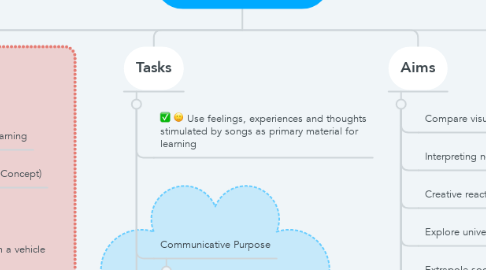
1. Advantages
1.1. Make learners more receptive to learning
1.2. Low the "Affective Filter" (Krashen Concept)
1.3. Songs are cultural artefacts
1.4. Repetitiveness of songs make them a vehicle for acquiring language
2. Song & Culture
2.1. Songs are product of culture
2.2. Representation of culture
2.3. Can influence culture
2.4. World Culture:
3. Tasks
3.1. Use feelings, experiences and thoughts stimulated by songs as primary material for learning
3.2. Communicative Purpose
3.2.1. Engaging
3.2.1.1. Task 1
3.2.1.2. Task 2
3.2.1.3. Task 3
3.2.1.4. Task 4
3.2.1.5. Task 5
3.2.1.6. Task 6
3.2.1.7. Task 8
3.2.1.8. Task 9
3.2.1.9. Task 11
3.2.1.10. Task 13
3.2.2. Provocative
3.2.2.1. Task 7
3.2.2.2. Task 12
3.3. Discourse Type
3.3.1. Pop Music Video
3.3.1.1. Task 13
3.3.2. Sound Effects
3.3.2.1. Task 12
3.3.3. Music
3.3.3.1. Task 11
3.3.4. Songs with a storyline
3.3.4.1. Task 10
3.3.5. Songs Theme
3.3.5.1. Task 9
3.3.6. Song Traditional
3.3.6.1. Task 8
3.3.7. Song Children's/ballad
3.3.7.1. Task 7
3.3.8. Song Music Evocative
3.3.8.1. Task 6
3.3.8.2. Task 5
3.3.9. Songs Generals
3.3.9.1. Task 1
3.3.9.2. Task 2
3.3.9.3. Task 3
3.3.9.4. Task 4
3.4. Authentic Task Typology
3.4.1. Response/Reaction
3.4.1.1. Task 1
3.4.1.2. Task 2
3.4.1.3. Task 4
3.4.1.4. Task 7
3.4.1.5. Task 11
3.4.1.6. Task 12
3.4.2. Transference
3.4.2.1. Task 3
3.4.2.2. Task 6
3.4.3. Extension
3.4.3.1. Task 5
3.4.4. Inferencing
3.4.4.1. Task 8
3.4.4.2. Task 9
3.4.5. Analysis
3.4.5.1. Task 13
